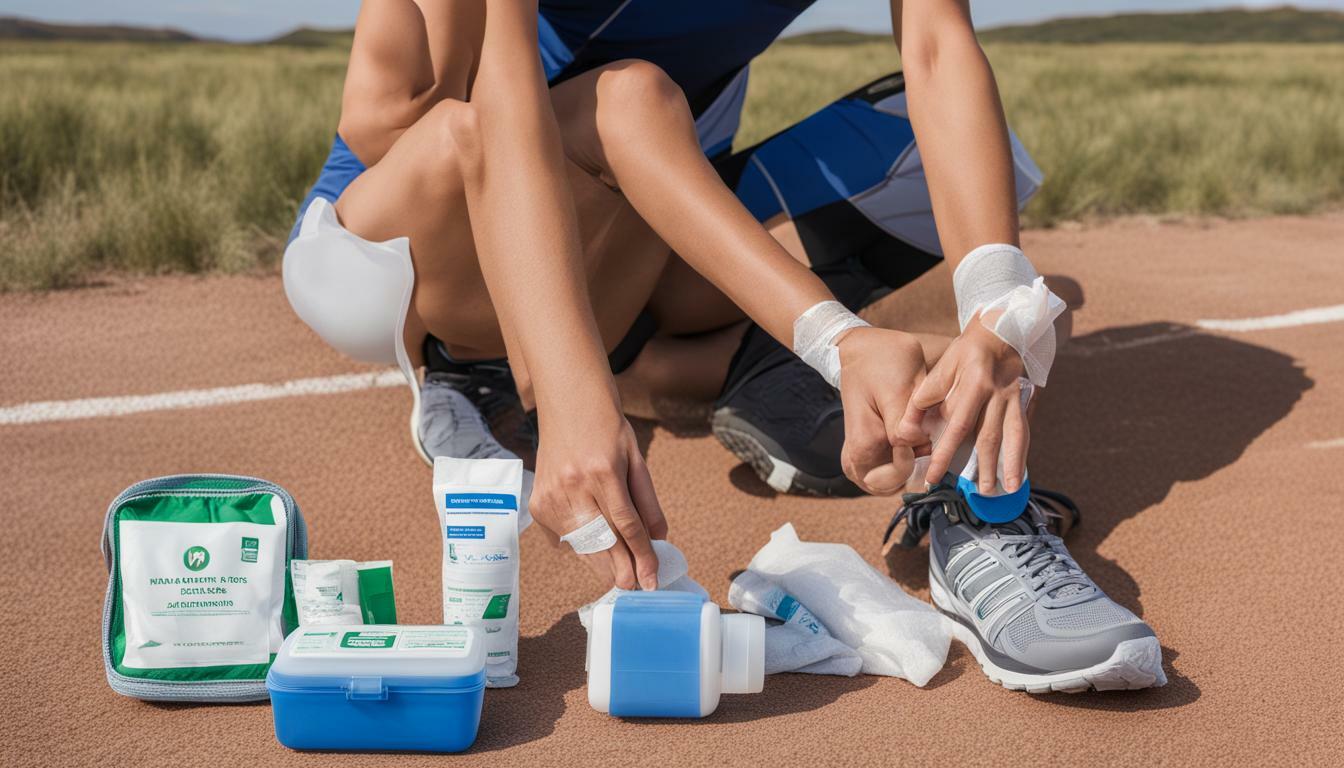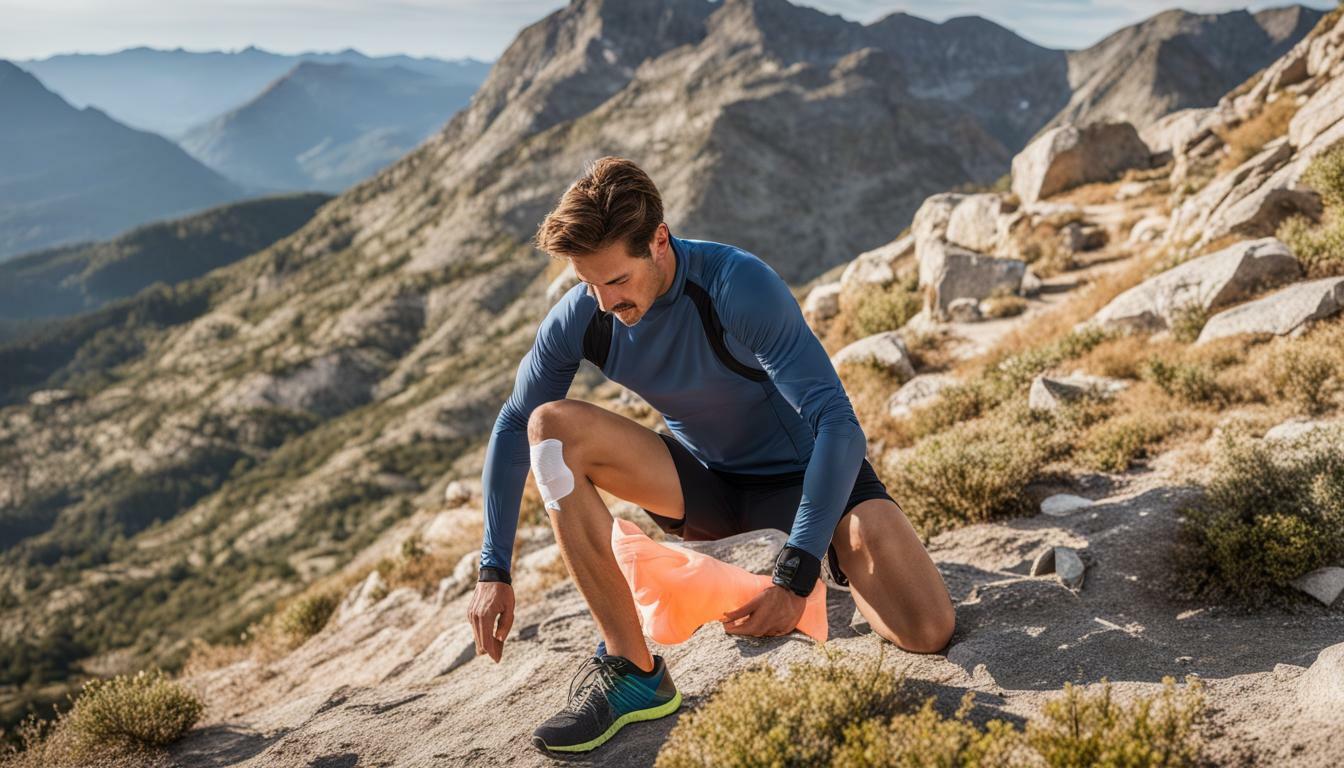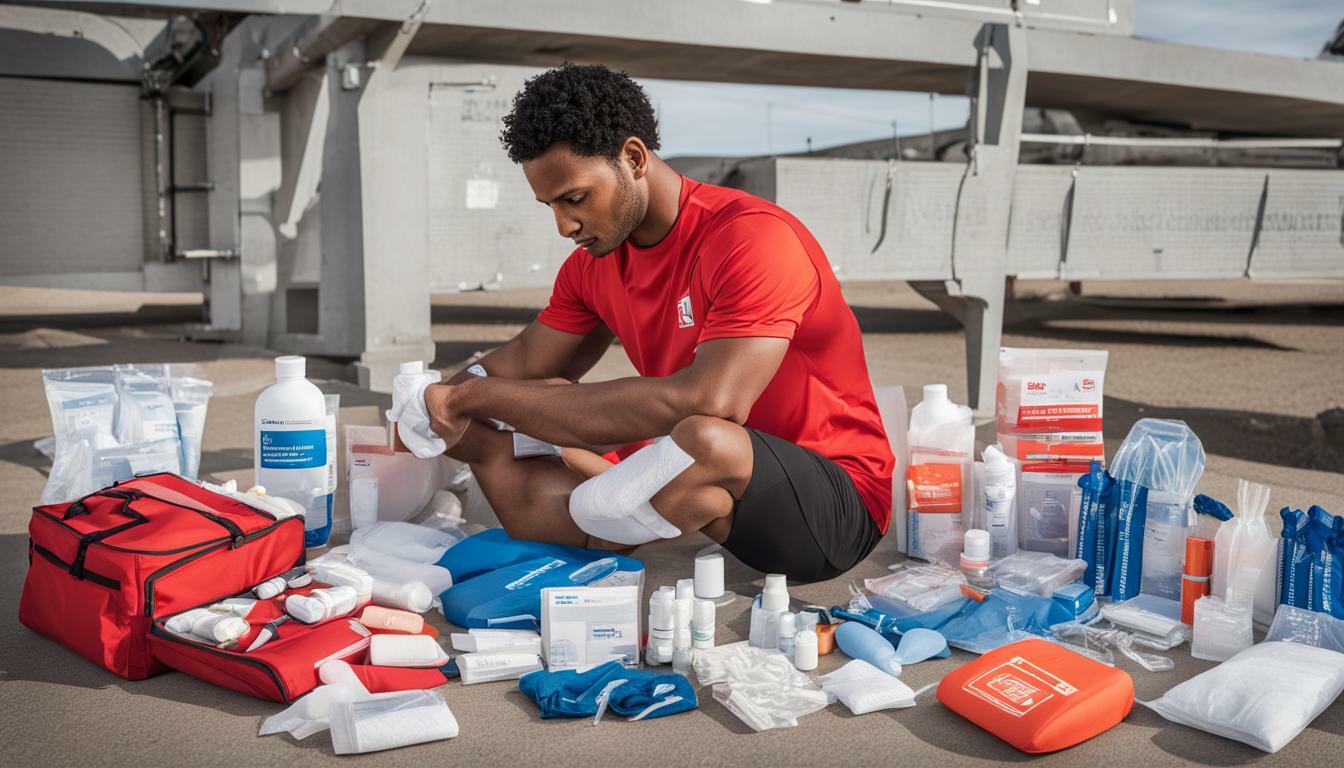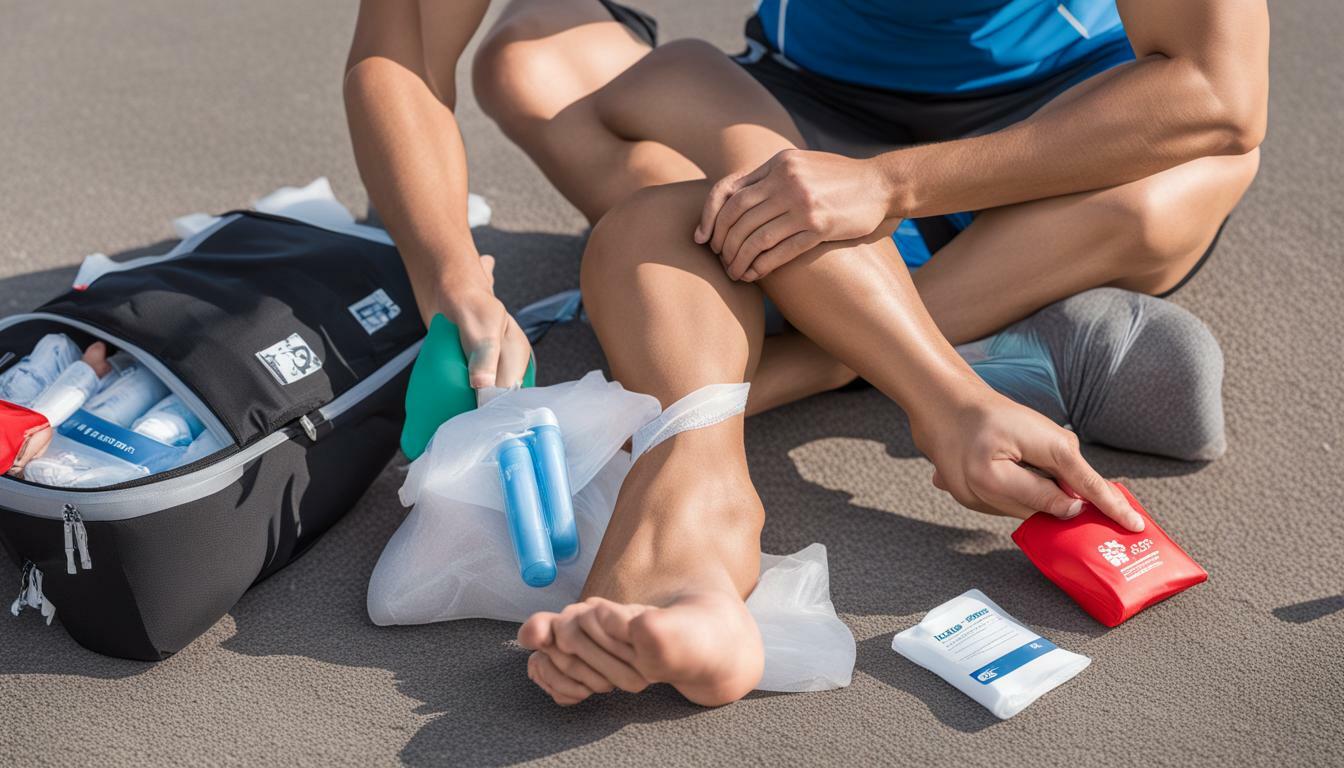Running is a popular and healthy activity. However, injuries can happen even to the most experienced runners. That’s why it’s important to have a first aid kit specifically designed for runners to help treat and prevent common running injuries. From blisters to muscle cramps and sprains, a well-stocked first aid kit can make a big difference in promoting recovery.
Runner first aid supplies should contain essential items such as bandages, pain relievers, blister treatments, and compression wraps. These items can effectively manage injuries and help runners get back on their feet quickly. In this article, we will explain the importance of having a runner’s first aid kit and provide information on treating common running injuries.
Key Takeaways:
- A first aid kit specifically designed for runners is essential for treating common running injuries.
- Runner first aid supplies should include items such as bandages, pain relievers, blister treatments, and compression wraps.
- Treating injuries quickly and effectively can promote recovery and help runners get back to their routine.
Understanding Running Injuries
Running is an excellent form of exercise and an effective way to stay fit. However, it is not without risks. Runners are susceptible to various injuries, which can significantly impact their running routine and overall health. In this section, we will discuss different types of running injuries and the appropriate first aid treatments.
Common Running Injuries
Wounds, sprains, strains, and blisters are some of the most common injuries that runners experience. Wounds can result from falls or scrapes and require proper cleaning to prevent infection. Sprains occur when the ligaments supporting a joint are overstretched or torn, and strains occur when a muscle is pulled or stretched beyond its limits. Blisters, on the other hand, are caused by continuous friction or pressure on the skin.
Regardless of the injury, it is essential to address it promptly to prevent further damage and promote healing.
First Aid for Running Injuries
First aid for running injuries typically involves four basic steps: rest, ice, compression, and elevation. Resting the affected part helps prevent further damage. Applying ice or a cold compress helps reduce swelling and inflammation. Compression helps prevent further swelling and supports the affected part. Elevation helps reduce swelling by promoting fluid drainage away from the affected area.
A runner’s first aid kit should include items such as bandages, gauze, antiseptic wipes, pain relievers, and compression wraps, among others. These items can help in treating wounds, blisters, strains, and sprains.
If the injury is severe or does not improve with basic first aid treatment, it is essential to seek professional medical attention. A medical professional can assess the injury and recommend appropriate treatment.

Overall, runners should take precautions to prevent injuries, such as wearing appropriate footwear and running on safe, well-lit surfaces. In case of an injury, prompt first aid treatment can help prevent further damage and promote healing.
Building Your Runner’s First Aid Kit
When it comes to running injuries, having a well-stocked first aid kit can make all the difference. In this section, we’ll guide you through the essential first aid items that every runner should have in their kit. We’ll also cover some tips for preventing and treating blisters and managing shin splints.

Essential First Aid Items for Runners
Here are some of the key items that should be included in every runner’s first aid kit:
| Item | Purpose |
|---|---|
| Bandages and Gauze | To cover and protect wounds and blisters |
| Pain Relievers | To manage pain and inflammation |
| Blister Treatments | To prevent and treat blisters |
| Compression Wraps | To reduce swelling and provide support |
| Antiseptic Wipes | To clean and disinfect wounds |
These items can be purchased in pre-packaged kits specifically designed for runners, or you can assemble your own kit using these key items as a guide.
Preventing and Treating Blisters
Blisters are a common running injury that can be painful and frustrating. To prevent blisters, make sure you wear properly fitting shoes and socks and consider using an anti-chafing balm. If you do develop a blister, make sure to clean and disinfect the area before covering it with a bandage or blister treatment. It’s also important to avoid popping the blister as it can increase the risk of infection.
Managing Shin Splints
Shin splints are another common injury among runners, characterized by pain and tenderness along the shin bone. To manage shin splints, rest and ice the affected area, and consider using compression wraps to reduce swelling. It’s also important to address any underlying issues that may be contributing to your shin splints, such as overpronation or flat feet.
By including these essential first aid items in your runner’s first aid kit, along with taking preventative measures and addressing any injuries promptly, you can keep yourself running strong and injury-free.
Ankle Injury First Aid, Muscle Cramp Relief for Runners and Runner’s Knee Treatment
Running is a fantastic way to stay fit and healthy, but it can come with its own set of risks. Running injuries can range from minor cuts and scrapes to more severe muscle sprains and bone fractures. In this section, we will discuss the first aid treatment for some common running injuries, including ankle injuries, muscle cramps, and runner’s knee.
Ankle Injury First Aid
Ankle injuries are common among runners. If you twist or sprain your ankle while running, it’s essential to stop immediately and assess the injury. Place an ice pack on the affected area to reduce inflammation and pain. Apply a compression bandage to support the ankle and reduce swelling. Rest and elevate your foot to reduce swelling further. Seek medical attention if you are in severe pain or unable to bear weight on the injured ankle.
Muscle Cramp Relief for Runners
Muscle cramps are sudden, painful contractions of the muscles. They can be caused by dehydration, electrolyte imbalances, or overuse of muscles. If you experience a muscle cramp while running, stop and stretch the affected muscle. Drink plenty of fluids to stay hydrated. Eat foods rich in electrolytes, such as bananas and coconut water. Avoid running for a few days to allow your muscles to recover.
Runner’s Knee Treatment
Runner’s knee is a common overuse injury that causes pain around the kneecap. It can be caused by weak thigh muscles, overtraining, or improper running shoes. If you experience runner’s knee, rest your knee and avoid running for a few days. Apply ice to the affected area to reduce inflammation and pain. Take over-the-counter pain relievers, such as ibuprofen. Wear proper running shoes and stretch your quadriceps muscles before and after running.
It’s vital to treat running injuries promptly and effectively to avoid further damage and promote healing. Your runner’s first aid kit should contain essential items such as bandages, ice packs, and pain relievers. Ensure that your first aid kit caters to your personal needs and any pre-existing conditions. Seek medical attention if the injury is severe or persistent.

The Importance of Rest and Recovery
Rest and recovery are essential components of any runner’s training routine. After a long run or a tough workout, it is important to give your body time to recover and repair itself. Failure to rest adequately can lead to a range of injuries and setbacks.
Here are some injury prevention tips:
- Get enough sleep: Adequate rest is crucial for your body to recover from the physical stress of running. Aim for seven to nine hours of sleep per night.
- Take rest days: Give your body time to recover by taking one or two rest days per week. Use this time to stretch, foam roll, or engage in non-impact activities like swimming or yoga.
- Listen to your body: Pay attention to any aches or pains you experience during or after a run. These can be signs of overuse or injury, and you should adjust your training accordingly.
In addition to these tips, there are also a number of recovery techniques that runners can use to aid in injury prevention:
- Stretching: Stretching after a run can help to prevent muscle tightness and promote flexibility.
- Hydration: Proper hydration is key to recovery. Make sure to replenish fluids lost during a run by drinking plenty of water throughout the day.
- Cross-training: Incorporating low-impact activities like cycling or swimming into your training routine can help to prevent overuse injuries.
By incorporating rest and recovery into your training routine, you can help to prevent injuries and keep your body in peak condition.

Seeking Professional Help
If you experience persistent pain or swelling, it may be time to seek professional medical attention. You should also seek medical help if you experience any sharp or sudden pain, or if you believe you have a serious injury.
It is important to recognize the signs that your injury requires professional attention so that you can receive timely treatment. Seek medical attention if you experience symptoms such as:
- Severe pain
- Significant swelling
- Difficulty bearing weight on the affected area
- Numbness or tingling
- Joint instability
If you do require professional medical help, sports injury clinics can offer specialized and immediate care for running injuries. These clinics have trained professionals who are equipped to diagnose and treat running injuries of all types.

Remember, the earlier you seek medical attention for your running injury, the faster you can begin your road to recovery. Don’t hesitate to seek professional help if you need it.
Maintaining a Safe Running Environment
Preventing running injuries is an essential part of any runner’s training routine. One of the best ways to achieve this is by maintaining a safe running environment. By taking safety precautions, runners can avoid injuries that can result from unforeseen circumstances while training.
One important safety precaution for runners is wearing appropriate footwear. Shoes that offer good support and cushioning can help reduce the impact on joints and muscles during running, thereby reducing the risk of injury. It’s also important to replace shoes on a regular basis to ensure they maintain their support and cushioning.

Another essential safety precaution is staying hydrated. Dehydration can lead to muscle fatigue, cramps, and other injuries. Runners should drink plenty of fluids before, during, and after training sessions to prevent dehydration.
Running in well-lit areas is also important to maintain a safe running environment. It helps runners see their surroundings and avoid obstacles that can cause injuries. It’s advisable to avoid running in poorly-lit areas, especially at night.
Other safety precautions for runners include warming up properly before training, avoiding running on slippery or uneven surfaces, and being aware of traffic when running on roads or other busy areas.
By taking the necessary safety precautions, runners can avoid injuries that can disrupt their training and bring about setbacks. Maintaining a safe running environment should be a priority for all runners who want to stay healthy and injury-free.
Incorporating First Aid Training
If you’re a runner, it’s important to not only have a well-stocked first aid kit but also to be equipped with the necessary skills to respond to emergencies effectively. This is where first aid training for runners comes in.
By investing time in first aid training, you can enhance your emergency response skills and learn how to handle common running injuries. This can include learning how to properly administer CPR, apply tourniquets, and deal with shock.
There are various first aid training programs available specifically for runners, including online courses and in-person training sessions. Some running clubs may also offer first aid classes, so it’s worth checking with your local group.
Remember, in an emergency situation, every second counts. By undergoing first aid training, you’ll be able to act quickly and confidently to provide the best possible care until medical help arrives.

Personalizing Your First Aid Kit
While a standard first aid kit for runners can help treat common injuries, every runner has unique needs. Therefore, it is essential to customize your first aid kit to suit your individual requirements. Here are some additional items you may want to consider including in your kit:
| Item | Purpose |
|---|---|
| Medications | If you have allergies or chronic conditions, such as asthma or diabetes, it’s important to include necessary medications in your first aid kit. Additionally, if you are prone to migraines or headaches during runs, pain relief medication is a must-have. |
| Tape | If you have a history of ankle or knee injuries, adding tape to your first aid kit can provide additional support and stability during runs. |
| Extra socks | Carrying an extra pair of socks can help prevent blisters and keep your feet dry if your primary pair gets wet during a run. |
| Ice packs | If you are prone to injuries such as muscle strains or sprains, having ice packs in your kit can provide immediate relief and help reduce swelling and inflammation. |
Remember, it’s crucial to regularly check and update your first aid kit to ensure that you have everything you need. Additionally, if you have any existing injuries or medical conditions, consult with your doctor to determine what additional items you should include in your kit.

Incorporating First Aid Training
While having a well-stocked first aid kit is essential for runners, it’s also important for runners to have the knowledge and skills to respond to injuries effectively. First aid training can enhance a runner’s ability to provide immediate and appropriate care to themselves or others in case of an injury.
Several organizations provide first aid training for runners, including courses that are specifically tailored to sports injuries. These courses cover topics such as wound care, CPR, and fracture management, among others. First aid training empowers runners to act swiftly and appropriately in case of an emergency.
Developing Emergency Response Skills
First aid training helps runners to develop emergency response skills that are critical in preventing further injury and providing the care necessary to promote recovery. Emergency response skills include assessing the severity of an injury, stabilizing the affected area, and providing basic life support, if necessary.
By developing emergency response skills, runners can feel confident and prepared to take immediate action when injuries occur. This can make a significant difference in the outcomes of injuries and can mean the difference between a speedy recovery and prolonged downtime.
Investing time and resources in first aid training is a valuable step for runners to take in ensuring they have the necessary skills to respond effectively to injuries. By doing so, runners can be better equipped to handle any injury-related situation that may arise while training or competing.
Conclusion
In conclusion, incorporating first aid training into a runner’s regimen is an important step in ensuring preparedness and safety. Runners who undergo first aid training acquire skills critical in preventing further injury and providing appropriate care. Together with a well-stocked first aid kit, first aid training is an essential component of any runner’s safety plan that can promote speedy recovery and prevent long-term downtime.
Investing time in obtaining first aid training will equip runners with invaluable skills that can make a significant difference in injury outcomes. Thus, it’s recommended that runners make first aid training a priority in their preparation and training for optimal safety and performance.
